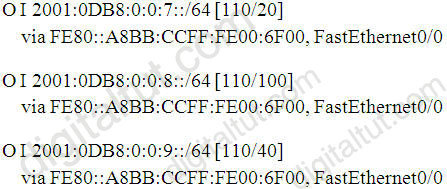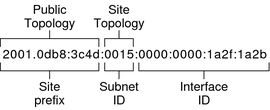IPv6 Questions 2
Note: If you are not sure about IPv6, please read our IPv6 tutorial.
Question 1
Explanation
IPv6 router advertisement message is one type of the ICMPv6 packets with Type field value of 134. It lists many facts, including the link-local IPv6 address of the router. Normally, it is sent to the all-IPv6-hosts local-scope multicast address of FF02::1. When sent in response to router solicitation messages (ICMPv6 Type 133), it flows back to either the unicast address of the host that sent the RS or to the all-IPv6-hosts address FF02::1.
The advertised IPv6 prefix length must be 64 bits for the stateless address autoconfiguration to be operational.
Question 2
Explanation
Below is the list of common kinds of IPv6 addresses:
| Loopback address | ::1 |
| Link-local address | FE80::/10 |
| Site-local address | FEC0::/10 (but it is deprecated and replaced with FC00::/7 for used in private networks) |
| Global address | 2000::/3 |
| Multicast address | FF00::/8 |
Question 3
Explanation
The “show ipv6 route” displays the current contents of the IPv6 routing table. This device is running OSPF so we can deduce it is running OSPFv3 (OSPF for IPv6). An example of the “show ip v6 route” is shown below:

Question 4
Explanation
To run IPv6 on an interface we have to configure an IPv6 on that interface somehow -> A is correct.
IPv6 must be enabled first but with the “ipv6 unicast-routing”, not “ipv6 enable” command -> D is not correct.
Question 5
Explanation
According to the official IANA website “Users are assigned IP addresses by Internet service providers (ISPs). ISPs obtain allocations of IP addresses from a local Internet registry (LIR) or National Internet Registry (NIR), or from their appropriate Regional Internet Registry (RIR): https://www.iana.org/numbers
Question 6
Explanation
An example of configuring RIPng (similar to RIPv2 but is used for IPv6) is shown below:
Router(config)#ipv6 unicast-routing (Enables the forwarding of IPv6 unicast datagrams globally on the router)
Router(config)#interface fa0/0
Router(config-if)#ipv6 rip 9tut enable (9tut is the process name of this RIPng)
Question 7
Explanation
Floating static routes are static routes that have an administrative distance greater than the administrative distance (AD) of another static route or dynamic routes. By default a static route has an AD of 1 then floating static route must have the AD greater than 1 -> Answer A is correct as it has the AD of 201.
Question 8
Explanation
Directly connected routes: In directly attached static routes, only the output interface is specified. The destination is assumed to be directly attached to this interface, so the packet destination is used as the next-hop address. This example shows such a definition:
ipv6 route 2001:DB8::/32 gigabitethernet1/0/0
The example specifies that all destinations with address prefix 2001:DB8::/32 are directly reachable through interface GigabitEthernet1/0/0.
Recursive Static Routes: In a recursive static route, only the next hop is specified. The output interface is derived from the next hop. This example shows such a definition:
ipv6 route 2001:DB8::/32 2001:DB8:3000:1
This example specifies that all destinations with address prefix 2001:DB8::/32 are reachable via the host with address 2001:DB8:3000:1.
Fully Specified Static Routes: In a fully specified static route, both the output interface and the next hop are specified. This form of static route is used when the output interface is a multi-access one and it is necessary to explicitly identify the next hop. The next hop must be directly attached to the specified output interface. The following example shows a definition of a fully specified static route:
ipv6 route 2001:DB8:/32 gigabitethernet1/0/0 2001:DB8:3000:1
A fully specified route is valid (that is, a candidate for insertion into the IPv6 routing table) when the specified IPv6 interface is IPv6-enabled and up.
Besides three of the static IPv routes, there is one more type of IPv6 static route, that is Floating Static Routes (static route with a higher administrative distance than the dynamic routing protocol it is backing up)
For more information about these IPv6 routes, please read: http://www.cisco.com/c/en/us/td/docs/ios-xml/ios/ipv6/configuration/xe-3s/ipv6-xe-36s-book/ip6-stat-routes.html
Question 9
Explanation
IPv6 includes two different unicast address assignments:
+ Global unicast address
+ Link-local address
The global unicast address is globally unique in the Internet. The example IPv6 address that is shown below is a global unicast address.

+ Site prefix (global routing prefix): defines the public topology of your network to a router. You obtain the site prefix for your enterprise from an ISP or Regional Internet Registry (RIR).
+ Site Topology and Subnet ID: the subnet ID defines an administrative subnet of the network and is up to 16 bits in length. You assign a subnet ID as part of IPv6 network configuration. The subnet prefix defines the site topology to a router by specifying the specific link to which the subnet has been assigned
+ Interface ID: identifies an interface of a particular node. An interface ID must be unique within the subnet.
Reference: https://docs.oracle.com/cd/E23823_01/html/816-4554/ipv6-overview-10.html
Question 10
Explanation
A IPv6 Unique Local Address is an IPv6 address in the block FC00::/7. It is the approximate IPv6 counterpart of the IPv4 private address. It is not routable on the global Internet.
Note: In the past, Site-local addresses (FEC0::/10) are equivalent to private IP addresses in IPv4 but now they are deprecated.


